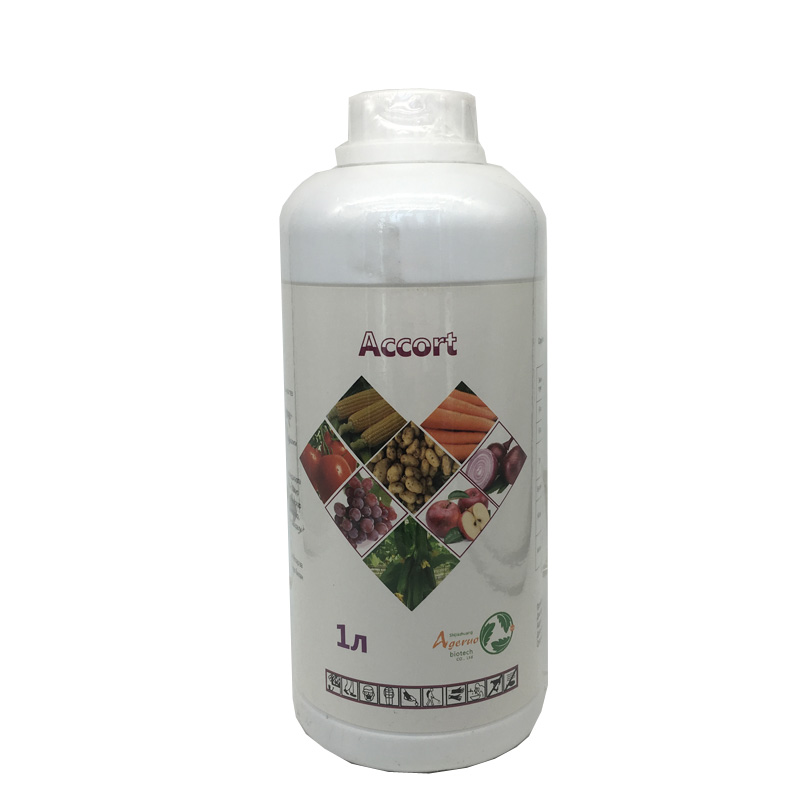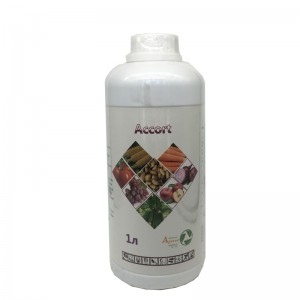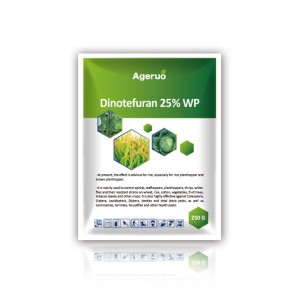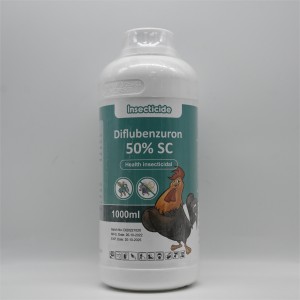Products
Cypermethrin 10% EC – Premium Insecticide for Broad-Spectrum Pest Control
| Item | Details |
|---|---|
| Active Ingredient & Formulation | Cypermethrin 10% EC (emulsifiable concentrate) |
| Chemical Class | Synthetic pyrethroid |
| CAS No. | 52315-07-8 |
| Mode of Action | Modifies voltage-gated sodium channels → continuous nerve firing → paralysis (contact + stomach action) |
| Target Crops | Cotton, rice, maize/corn, soybeans, fruits, vegetables, cereals, ornamentals |
| Target Insects | Lepidoptera (bollworms, armyworms, loopers), Hemiptera (aphids, whiteflies, leafhoppers), Coleoptera (beetles), Diptera (flies, mosquitoes) |
| Packaging (stock) | 100 ml HDPE bottle, 1 L HDPE bottle (tamper-evident) |
| MOQ | 500 L |
| Other Formulations | Cypermethrin 2.5% EC, Cypermethrin 5% EC |
| Documents | COA, MSDS, label artwork (OEM), ISO 9001 & SGS verification |
| Intended Use | Agricultural pest control; public health vector control (per local label) |
Cypermethrin 10% EC is a synthetic pyrethroid emulsifiable concentrate designed for fast knockdown and 2–3 weeks of residual control against major chewing and sucking pests. With dual contact and stomach action, it protects cotton, rice, maize, soybeans, vegetables, fruits, cereals, and ornamentals in both open-field and greenhouse systems. The formulation performs reliably across varied climates, integrates smoothly into existing spray programs, and supports OEM/ODM needs with flexible packaging (100 ml / 1 L) and full documentation (COA, MSDS, ISO/SGS). It is also applicable to public health vector control per local label directions.
Use Cases (typical):
-
In-season rescue: Rapid suppression of bollworms/armyworms during pressure spikes.
-
Program partner: Alternates with different MOA products to maintain season-long efficacy.
-
Export crops: Consistent field performance to protect visual quality and marketable yield.
Key Features & Benefits
Cypermethrin 10% EC delivers reliable field performance with a balance of speed, spectrum, and economy—ideal for distributors and growers seeking consistent results season after season.
1) Fast Knockdown
-
Function: Synthetic pyrethroid acts rapidly on insect sodium channels.
-
Benefit: Immediate suppression of active infestations (bollworms, armyworms, aphids, whiteflies).
-
Result: Visible control within a short window, reducing early crop loss.
2) Long-Lasting Residual (2–3 Weeks)
-
Function: Stable EC formulation adheres to foliage and persists under typical conditions.
-
Benefit: Extended protection reduces respray frequency.
-
Result: Lower labor and fuel costs; steadier protection through key growth stages.
3) Broad-Spectrum Coverage
-
Function: Dual contact + stomach action effective on chewing & sucking pests.
-
Benefit: One product addresses multiple insect groups across diverse crops.
-
Result: Simplified inventory and logistics for dealers and farms.
4) Flexible Program Fit
-
Function: Works as a rescue spray or as part of a rotation with different MOA products.
-
Benefit: Supports IRM(Insect Resistance Management)programs.
-
Result: Sustained efficacy across seasons, protecting brand reputation.
5) Consistent Quality & Compliance
-
Function: ISO 9001 production, SGS verification, COA/MSDS available.
-
Benefit: Smooth registration and buyer audits in export markets.
-
Result: Faster time-to-market and fewer compliance risks.
6) OEM/ODM Ready
-
Function: Custom labels, multilingual artwork, and packaging options (100 ml / 1 L).
-
Benefit: Brand differentiation for distributors/retailers.
-
Result: Stronger shelf presence and repeat orders.
Mode of Action
Cypermethrin 10% EC belongs to the synthetic pyrethroid group of insecticides and exerts its effect through a neurotoxic mechanism that disrupts the normal function of the insect’s nervous system.
1) Target Site: Sodium Channel Modulation
Cypermethrin binds to and modifies the gating kinetics of voltage-gated sodium channels in nerve membranes. This causes continuous depolarization, repetitive firing of nerve impulses, and loss of coordination, leading to paralysis and death.
2) Dual Pathways of Action
-
Contact Action: Insects absorb the chemical directly through the cuticle upon exposure.
-
Stomach Action: When ingested with treated plant material, it acts internally, providing dual assurance of control.
3) Rapid & Residual Effect
The formulation delivers an immediate knockdown within hours and residual activity lasting up to 2–3 weeks, depending on environmental conditions.
4) IRAC Classification
-
Mode of Action Group: 3A (Sodium channel modulators)
-
Recommended Use: Rotate with insecticides from different IRAC groups to prevent resistance build-up.
The dual contact and ingestion pathways provide both quick suppression and extended protection, making Cypermethrin 10% EC a cornerstone insecticide in modern pest management programs.
Target Pests & Crops
Cypermethrin 10% EC provides reliable control of chewing and sucking pests across staple and high-value crops in open-field and greenhouse systems.
Recommended Crop Applications & Key Pests
| Crop | Primary Pests | Protection Focus / Outcome |
|---|---|---|
| Cotton | Bollworms (Helicoverpa spp.), Armyworms, Aphids, Whiteflies | Protects squares/bolls; reduces lint staining and yield loss |
| Rice | Leaf folders, Stem borers, Planthoppers | Safeguards tillering and grain fill; minimizes hopperburn |
| Maize/Corn | Fall armyworm (Spodoptera frugiperda), Cutworms | Preserves whorl/ear health; prevents stand loss |
| Soybeans | Caterpillars, Bean aphid, Leaf beetles | Maintains leaf area; supports pod set and seed weight |
| Vegetables (tomato, pepper, cucumber, brassicas) | Fruit borers, Cabbage looper, Leafminers, Aphids, Whiteflies | Improves marketable appearance; reduces secondary infections |
| Fruits (citrus, pome, stone) | Leafminers, Fruit borers, Mealybugs | Lowers scarring and drop; enhances pack-out grade |
| Cereals (wheat, barley, sorghum) | Armyworms, Aphids | Protects flag leaf/photosynthesis; stabilizes yield |
| Ornamentals | Caterpillars, Aphids, Whiteflies | Maintains aesthetic value; supports export quality |
| Public Health (per local label) | Mosquitoes, Houseflies | Vector reduction around facilities and storage areas |
Target timing: early detection to early larval stages; ensure thorough foliar coverage (leaf undersides).
Application & Dosage
Cypermethrin 10% EC should be applied at the early pest infestation stage to ensure maximum efficacy. Thorough foliar coverage—especially on the undersides of leaves—is critical for optimal control.
Recommended Application Guidelines
| Crop | Target Pests | Dosage (ml/ha) | Application Interval | Notes / Remarks |
|---|---|---|---|---|
| Cotton | Bollworms, Aphids, Whiteflies | 220–300 | 7–10 days | Apply at early boll stage; avoid flowering time to protect pollinators |
| Rice | Leaf folders, Planthoppers | 200–250 | 10–14 days | Maintain flooded conditions during application for better coverage |
| Maize/Corn | Fall armyworm, Cutworms | 200–250 | 7–10 days | Apply to whorl stage or early ear formation |
| Soybeans | Caterpillars, Aphids | 220–280 | 10 days | Ensure full canopy penetration for uniform coverage |
| Vegetables (Tomato, Pepper, Cucumber) | Fruit borers, Leafminers, Thrips | 150–200 | 7 days | Repeat based on pest pressure; avoid high temperature hours |
| Citrus & Fruits | Leafminers, Mealybugs | 150–200 | 14 days | Apply at early flush and fruit development stage |
| Cereals & Ornamentals | Armyworms, Aphids | 200–250 | 10–14 days | Avoid windy conditions; ensure drift control |
| Public Health Use | Mosquitoes, Houseflies | 25–50 ml per 10 L water | As required | For perimeter or surface spray; follow local regulations |
Mixing & Spray Instructions
-
Spray Type: Foliar spray using knapsack, power, or boom sprayer.
-
Water Volume: 400–800 L/ha, depending on crop canopy density.
-
Mixing Order: Half-fill tank with water → add measured Cypermethrin → agitate → top up with water while stirring.
-
Compatibility: Compatible with most insecticides and fungicides except highly alkaline formulations. Always perform a jar test before tank mixing.
Pre-Harvest Interval (PHI)
-
Typical PHI: 7 days for vegetables and fruits; follow national label guidelines where applicable.
Always read and follow label directions. Avoid spraying during strong winds or near water bodies.
Safety Guidelines
Cypermethrin 10% EC must be handled and applied strictly according to the registered label and local regulations. The following guidance supports safe use in agricultural and public-health scenarios.
Personal Protective Equipment (PPE)
-
Wear chemical-resistant gloves, long sleeves/trousers, closed shoes, and eye/face protection; use a respirator where ventilation is poor or aerosol exposure is likely.
-
Wash hands, face, and exposed skin after mixing/spraying and before eating or smoking.
-
Launder contaminated clothing separately.
Mixing & Application Safety
-
Mix in a well-ventilated area; avoid splashes and do not inhale spray mist.
-
Keep bystanders and animals away from treated zones.
-
Drift control: avoid windy conditions; use appropriate nozzles and pressure; maintain buffer zones near water bodies and apiaries.
Re-Entry & Pre-Harvest
-
Restricted-Entry Interval (REI): Follow local label; if unspecified, delay re-entry until spray deposits are dry; wear PPE if early entry is required.
-
Pre-Harvest Interval (PHI): Typically 7 days for many fruit/vegetable crops—always follow national label.
Storage & Transport
-
Store in original, sealed containers in a cool, dry, locked, and ventilated place, away from food/feed and ignition sources.
-
Keep out of reach of children and unauthorized personnel.
-
Transport upright; protect from heat and sunlight.
Spill & Disposal
-
Small spill: Contain with absorbent (sand/earth), collect into labeled container for disposal per local regulations.
-
Rinse water & leftovers: Do not discharge to drains or waterways. Triple-rinse empty containers and dispose/recycle according to local rules.
First Aid (General)
-
Skin contact: Remove contaminated clothing; wash with soap and water.
-
Eye contact: Rinse cautiously with clean water for 15 minutes; remove contact lenses if easy.
-
Inhalation: Move to fresh air; keep warm and at rest.
-
Ingestion: Do not induce vomiting; rinse mouth; seek medical attention immediately.
-
Present product label/MSDS to healthcare providers.
This guidance does not replace the registered label. Always follow national regulations and product-specific instructions.
Environmental Impact
Cypermethrin 10% EC is moderately toxic to mammals and highly toxic to fish and bees. Responsible stewardship and correct timing/application are essential to minimize ecological risk.
Aquatic Organisms
-
High aquatic toxicity: Prevent contamination of waterways, drains, and irrigation canals.
-
Buffer zones: Maintain no-spray buffer strips near ponds, streams, and drainage ditches.
-
Equipment hygiene: Do not rinse tanks or dispose of washings in or near water bodies.
Pollinators & Beneficials
-
Bees: Avoid spraying during bloom and periods of peak bee activity; apply in early morning or late afternoon.
-
Natural enemies: Use spot or edge treatments where possible to conserve predators/parasitoids; integrate with biological controls.
Soil & Non-Target Plants
-
Apply at labeled rates to avoid runoff and off-target drift.
-
Use drift-reducing nozzles, appropriate boom height, and moderate pressure; avoid strong winds.
Resistance & Sustainability
-
Rotate with different IRAC groups and integrate with IPM (monitoring, thresholds, cultural controls) to reduce selection pressure and maintain long-term field performance.
Never apply directly to water. Collect and dispose of residues according to local environmental regulations.
Certifications & Compliance
We manufacture and supply Cypermethrin 10% EC under robust quality systems and export requirements to support smooth registration and market entry.
-
Quality Systems: ISO 9001 certified production; batch-wise COA with assay, pH, emulsifiability, stability; SGS verification available on request.
-
Safety Documents: Full MSDS, label & SDS in multiple languages; transport classification per local rules.
-
Label & Packaging Compliance: GHS pictograms and hazard statements; child-resistant, tamper-evident closures; UN-rated options for hazardous goods.
-
Regulatory Support: Data package for registration (specification sheet, manufacturing process overview, stability outline, residue statement where applicable).
-
Traceability: Unique batch/lot coding and retained samples for post-market investigation.
All exports follow destination-country pesticide regulations. Final label content must reflect local registration.
FAQ
Q1. Is Cypermethrin 10% EC suitable for both field and greenhouse crops?
Yes. Ensure adequate ventilation in greenhouses and avoid spraying during high temperatures to reduce phytotoxicity risk.
Q2. Can it be tank-mixed with other products?
Generally yes, except with highly alkaline formulations. Always conduct a jar test before large-scale mixing.
Q3. What is the typical residual period?
Approximately 2–3 weeks, depending on pest pressure, crop canopy, and weather.
Q4. What PHI/REI should I follow?
Typical PHI ~7 days; REI as per national label. Always follow your local registered label.
Q5. Do you provide OEM documents for registration and audits?
Yes—COA, MSDS, ISO/SGS, label artwork, and a basic regulatory data pack to support registration and buyer audits.
Q6. Any precautions for bees and fish?
Avoid applications during bloom and near water bodies; maintain buffer zones and apply during low bee activity (early morning/late afternoon).
Why Choose Us
Partner with a supplier who understands performance, compliance, and speed to market. We deliver consistent quality, flexible OEM, and on-time shipments to help you win your category.
-
Proven Manufacturing – ISO 9001 plants, strict QC, batch COA, SGS-inspected shipments.
-
OEM/ODM at Scale – Multilingual labels, custom packs (100 ml / 1 L), artwork support.
-
Regulatory Ready – COA, MSDS, data pack to streamline market registration.
-
Reliable Logistics – Stable lead times and export experience across MEA, LATAM, Central Asia.
Contact us today to request pricing, samples, and a full technical data package for Cypermethrin 10% EC—let’s build your market advantage together.
|
Crops |
Target insects |
Dosage |
Using Method |
|
|
Cypermethrin 10%EC |
Cotton |
Cotton bollworm Pink worm |
105-195ml/ha |
spray |
|
Wheat |
Aphid |
370-480ml/ha |
spray |
|
|
Vegetable |
Plutella Xylostella Cabbage Caterpillar |
80-150ml/ha |
spray |
|
|
Fruit trees |
Grapholita |
1500-3000times liquid |
spray |
When using cypermethrin or any pesticide, it is crucial to follow safety guidelines and best practices to protect yourself, others, and the environment. Here are some important points to consider when using cypermethrin:
- Read the label: Carefully read and follow all instructions on the pesticide label. The label provides essential information about proper handling, application rates, target pests, safety precautions, and first aid measures.
- Wear protective clothing: When handling cypermethrin or applying it, wear appropriate personal protective equipment (PPE) such as gloves, long-sleeved shirts, long pants, and closed-toe shoes to minimize direct skin contact.
- Use in well-ventilated areas: Apply cypermethrin in well-ventilated outdoor areas to reduce the risk of inhalation exposure. Avoid applying in windy conditions to prevent drift to non-target areas.
- Avoid contact with eyes and mouth: Keep cypermethrin away from your eyes, mouth, and nose. In case of accidental contact, immediately rinse with water.
- Keep children and pets away: Ensure that children and pets are kept away from treated areas during and after application. Follow the re-entry period specified on the product label before allowing access to treated areas.


















